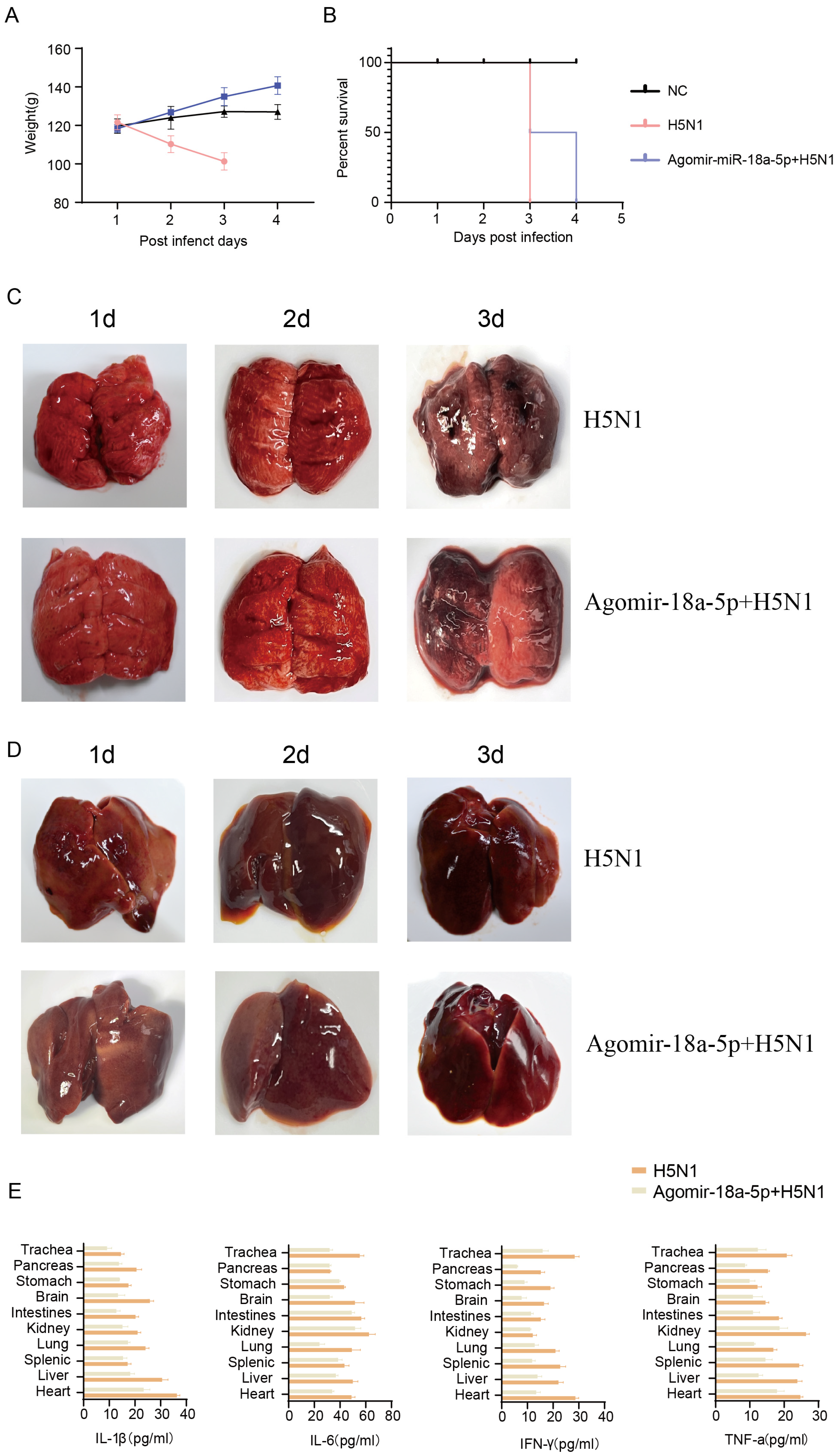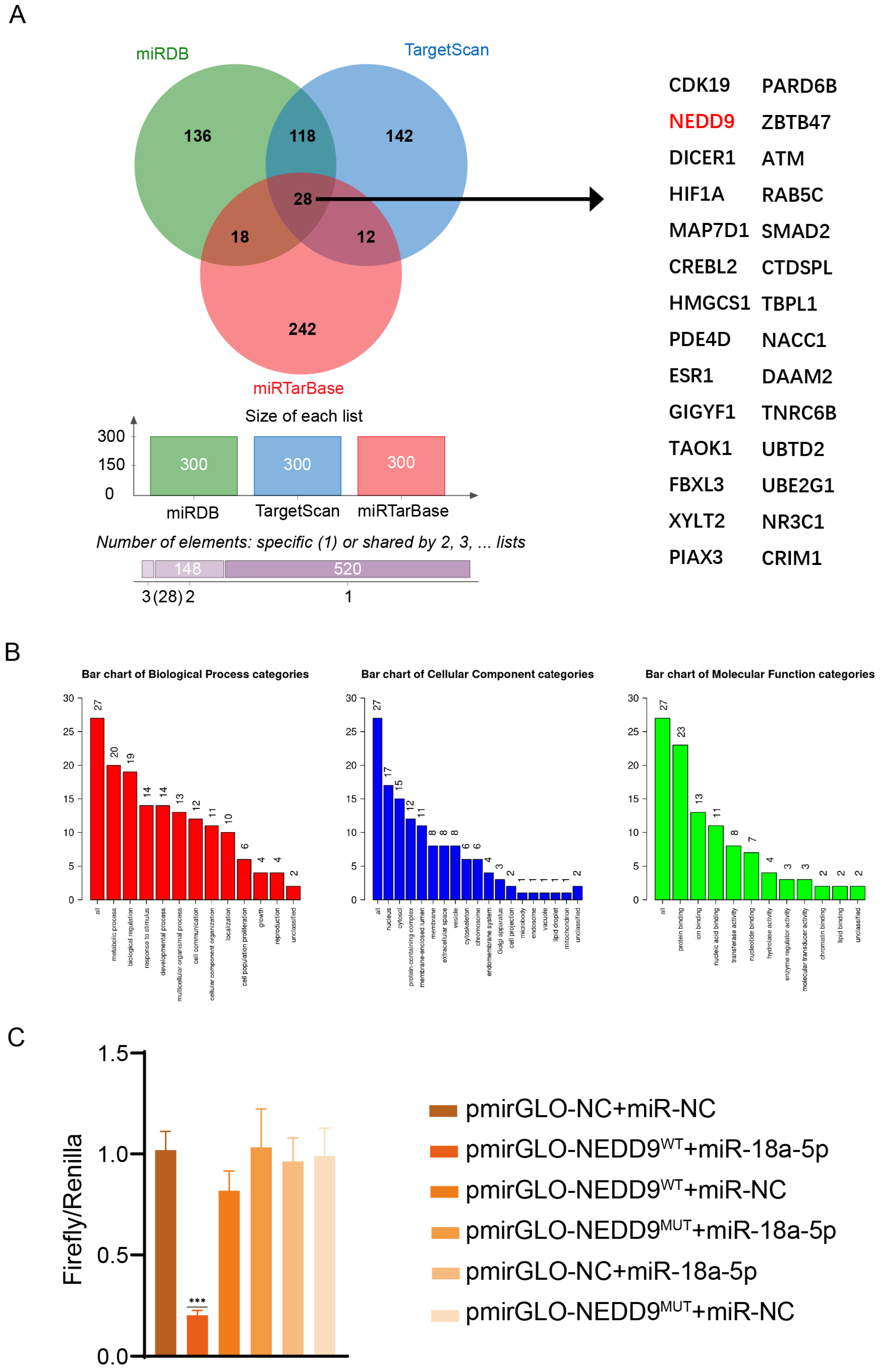Mechanisms of miR-18a-5p Target NEDD9-Mediated Suppression of H5N1 Influenza Virus in Mammalian and Avian Hosts
Simple Summary
Abstract
1. Introduction
2. Materials and Methods
2.1. Ethics Statement and Biosafety
2.2. Cell Lines, Viruses, and Animals
2.3. Extraction of RNA
2.4. MiRNA Quantification
2.5. MiRNAs and miRNA Transfection
2.6. Virus Infection
2.7. Infection in Animals
2.8. Pathological Examination
2.9. Immunofluorescence Tissue Staining
2.10. Analysis of Cytokines and Chemokines
2.11. Antibody
2.12. Western Blotting
2.13. Luciferase Reporter Gene Assay
2.14. Statistical Analysis
3. Results
3.1. miR-18a-5p Attenuates AIV Replication In Vitro
3.2. miR-18a-5p Inhibits the Expression of Pro-Inflammatory Cytokines
3.3. miR-18a-5p Attenuates AIV Replication in Mammals
3.4. miR-18a-5p Attenuates AIV Replication in Poultry Animals
3.5. NEDD9 Is the Target of miR-18a-5p
3.6. NEDD9 Promotes Influenza Virus Replication
4. Discussion
5. Conclusions
The Limitations of This Research
Supplementary Materials
Author Contributions
Funding
Institutional Review Board Statement
Informed Consent Statement
Data Availability Statement
Acknowledgments
Conflicts of Interest
References
- AbuBakar, U.; Amrani, L.; Kamarulzaman, F.A.; Karsani, S.A.; Hassandarvish, P.; Khairat, J.E. Avian Influenza Virus Tropism in Humans. Viruses 2023, 15, 833. [Google Scholar] [CrossRef] [PubMed]
- Ward, R.D.; ElNaiem, D.; Garros, C. Guest editorial for a special issue of “Infection, genetics and evolution” on the vector biology of infectious diseases 2014. Infect. Genet. Evol. 2014, 28, 572. [Google Scholar] [CrossRef] [PubMed]
- Wu, Y.; Wu, Y.; Tefsen, B.; Shi, Y.; Gao, G.F. Bat-derived influenza-like viruses H17N10 and H18N11. Trends Microbiol. 2014, 22, 183–191. [Google Scholar] [CrossRef] [PubMed]
- Belser, J.A.; Barclay, W.S.; Barr, I.G.; Fouchier, R.A.M.; Matsuyama, R.; Nishiura, H.; Peiris, M.; Russell, C.J.; Subbarao, K.; Zhu, H. Ferrets as Models for Influenza Virus Transmission Studies and Pandemic Risk Assessments. Emerg. Infect. Dis. 2018, 24, 965–971. [Google Scholar] [CrossRef] [PubMed]
- Herfst, S.; Schrauwen, E.J.; Linster, M.; Chutinimitkul, S.; de Wit, E.; Munster, V.J.; Sorrell, E.M.; Bestebroer, T.M.; Burke, D.F.; Smith, D.J.; et al. Airborne transmission of influenza A/H5N1 virus between ferrets. Science 2012, 336, 1534–1541. [Google Scholar] [CrossRef]
- Rimondi, A.; Vanstreels, R.E.T.; Olivera, V.; Donini, A.; Lauriente, M.M.; Uhart, M.M. Highly Pathogenic Avian Influenza A(H5N1) Viruses from Multispecies Outbreak, Argentina, August 2023. Emerg. Infect. Dis. 2024, 30, 812–814. [Google Scholar] [CrossRef]
- Belser, J.A.; Maines, T.R.; Tumpey, T.M.; Katz, J.M. Influenza A virus transmission: Contributing factors and clinical implications. Expert. Rev. Mol. Med. 2010, 12, e39. [Google Scholar] [CrossRef]
- Roers, A.; Hiller, B.; Hornung, V. Recognition of Endogenous Nucleic Acids by the Innate Immune System. Immunity 2016, 44, 739–754. [Google Scholar] [CrossRef] [PubMed]
- Sannula, K.; Kanneganti, T.-D. Mechanism of Influenza Virus Induced Inflammatory Cell Death. J. Immunol. 2019, 202, 74.8. [Google Scholar] [CrossRef]
- Choi, Y.; Bowman, J.W.; Jung, J.U. Autophagy during viral infection—a double-edged sword. Nat. Rev. Microbiol. 2018, 16, 341–354. [Google Scholar] [CrossRef]
- Li, X.; Fu, Z.; Liang, H.; Wang, Y.; Qi, X.; Ding, M.; Sun, X.; Zhou, Z.; Huang, Y.; Gu, H.; et al. H5N1 influenza virus-specific miRNA-like small RNA increases cytokine production and mouse mortality via targeting poly(rC)-binding protein 2. Cell Res. 2018, 28, 157. [Google Scholar] [CrossRef] [PubMed]
- Long, J.S.; Mistry, B.; Haslam, S.M.; Barclay, W.S. Host and viral determinants of influenza A virus species specificity. Nat. Rev. Microbiol. 2019, 17, 67–81. [Google Scholar] [CrossRef] [PubMed]
- Tome-Amat, J.; Ramos, I.; Amanor, F.; Fernández-Sesma, A.; Ashour, J. Influenza A Virus Utilizes Low-Affinity, High-Avidity Interactions with the Nuclear Import Machinery To Ensure Infection and Immune Evasion. J. Virol. 2019, 93, e01046-18. [Google Scholar] [CrossRef] [PubMed]
- Han, J.; Perez, J.T.; Chen, C.; Li, Y.; Benitez, A.; Kandasamy, M.; Lee, Y.; Andrade, J.; Manicassamy, B. Genome-wide CRISPR/Cas9 Screen Identifies Host Factors Essential for Influenza Virus Replication. Cell Rep. 2018, 23, 596–607. [Google Scholar] [CrossRef] [PubMed]
- Yasin, J.A.; Odat, R.M.; Qtaishat, F.A.; Tamimi, M.A.; Alsufi, M.I.; Younis, O.M.; Alkuttob, L.A.; Saeed, A. The Prognostic Significance of NEDD9 Expression in Human Cancers: A Systematic Review, Meta-Analysis, and Omics Exploration. Technol. Cancer Res. Treat. 2024, 23, 15330338241297597. [Google Scholar] [CrossRef] [PubMed]
- Meng, H.; Wu, J.; Huang, Q.; Yang, X.; Yang, K.; Qiu, Y.; Ren, J.; Shen, R.; Qi, H. NEDD9 promotes invasion and migration of colorectal cancer cell line HCT116 via JNK/EMT. Oncol. Lett. 2019, 18, 4022–4029. [Google Scholar] [CrossRef]
- Tang, L.; Xu, S.; Wei, R.; Fan, G.; Zhou, J.; Wei, X.; Xu, X. Transcription factor 7 like 2 promotes metastasis in hepatocellular carcinoma via NEDD9-mediated activation of AKT/mTOR signaling pathway. Mol. Med. 2024, 30, 108. [Google Scholar] [CrossRef]
- Lyu, J.; Okada, H.; Sunagozaka, H.; Kawaguchi, K.; Shimakami, T.; Nio, K.; Murai, K.; Shirasaki, T.; Yoshida, M.; Arai, K.; et al. Potential utility of l-carnitine for preventing liver tumors derived from metabolic dysfunction-associated steatohepatitis. Hepatol. Commun. 2024, 8, e0425. [Google Scholar] [CrossRef] [PubMed]
- Hu, Y.; Chen, H.; Yang, M.; Xu, J.; Liu, J.; He, Q.; Xu, X.; Ji, Z.; Yang, Y.; Yan, M.; et al. Hepatocyte growth factor facilitates the repair of spinal cord injuries by driving the chemotactic migration of mesenchymal stem cells through the β-catenin/TCF4/Nedd9 signaling pathway. Stem Cells 2024, 42, 957–975. [Google Scholar] [CrossRef] [PubMed]
- Golumba-Nagy, V.; Yan, S.; Steinbach-Knödgen, E.; Thiele, J.; Esser, R.L.; Haak, T.H.; Nikiforov, A.; Meyer, A.; Seeger-Nukpezah, T.; Kofler, D.M. Treatment of rheumatoid arthritis with baricitinib or upadacitinib is associated with reduced scaffold protein NEDD9 levels in CD4+ T cells. Physiol. Rep. 2023, 11, e15829. [Google Scholar] [CrossRef]
- Li, Y.; Masaki, T.; Yamane, D.; McGivern, D.R.; Lemon, S.M. Competing and noncompeting activities of miR-122 and the 5′ exonuclease Xrn1 in regulation of hepatitis C virus replication. Proc. Natl. Acad. Sci. USA 2013, 110, 1881–1886. [Google Scholar] [CrossRef] [PubMed]
- Chang, J.; Guo, J.T.; Jiang, D.; Guo, H.; Taylor, J.M.; Block, T.M. Liver-specific microRNA miR-122 enhances the replication of hepatitis C virus in nonhepatic cells. J. Virol. 2008, 82, 8215–8223. [Google Scholar] [CrossRef] [PubMed]
- Chen, J.; Zhao, S.; Cui, Z.; Li, W.; Xu, P.; Liu, H.; Miao, X.; Chen, Y.; Han, F.; Zhang, H.; et al. MicroRNA-376b-3p Promotes Porcine Reproductive and Respiratory Syndrome Virus Replication by Targeting Viral Restriction Factor TRIM22. J. Virol. 2022, 96, e0159721. [Google Scholar] [CrossRef]
- Liu, X.; Zhang, Y.; Wang, P.; Wang, H.; Su, H.; Zhou, X.; Zhang, L. HBX Protein-Induced Downregulation of microRNA-18a is Responsible for Upregulation of Connective Tissue Growth Factor in HBV Infection-Associated Hepatocarcinoma. Med. Sci. Monit. 2016, 22, 2492–2500. [Google Scholar] [CrossRef] [PubMed]
- Xu, J.; An, P.; Winkler, C.A.; Yu, Y. Dysregulated microRNAs in Hepatitis B Virus-Related Hepatocellular Carcinoma: Potential as Biomarkers and Therapeutic Targets. Front. Oncol. 2020, 10, 1271. [Google Scholar] [CrossRef] [PubMed]
- Yang, Z.; Zhuo, Q.; Qin, W.; Wang, J.; Wang, L.; Tien, P. MicroRNAs miR-18a and miR-452 regulate the replication of enterovirus 71 by targeting the gene encoding VP3. Virus Genes. 2021, 57, 318–326. [Google Scholar] [CrossRef]
- Cao, P.; Zhang, M.; Wang, L.; Sai, B.; Tang, J.; Luo, Z.; Shuai, C.; Zhang, L.; Li, Z.; Wang, Y.; et al. Correction to: miR-18a reactivates the Epstein-Barr virus through defective DNA damage response and promotes genomic instability in EBV-associated lymphomas. BMC Cancer 2019, 19, 189. [Google Scholar] [CrossRef]
- Saetrom, P.; Snøve, O.; Nedland, M.; Grünfeld, T.B.; Lin, Y.; Bass, M.B.; Canon, J.R. Conserved microRNA characteristics in mammals. Oligonucleotides 2006, 16, 115–144. [Google Scholar] [CrossRef]
- Mogilyansky, E.; Rigoutsos, I. The miR-17/92 cluster: A comprehensive update on its genomics, genetics, functions and increasingly important and numerous roles in health and disease. Cell Death Differ. 2013, 20, 1603–1614. [Google Scholar] [CrossRef] [PubMed]
- Haroun, R.A.; Osman, W.H.; Eessa, A.M. Prognostic significance of serum miR-18a-5p in severe COVID-19 Egyptian patients. J. Genet. Eng. Biotechnol. 2023, 21, 114. [Google Scholar] [CrossRef]
- Ackermann, M.; Verleden, S.E.; Kuehnel, M.; Haverich, A.; Welte, T.; Laenger, F.; Vanstapel, A.; Werlein, C.; Stark, H.; Tzankov, A.; et al. Pulmonary Vascular Endothelialitis, Thrombosis, and Angiogenesis in Covid-19. N. Engl. J. Med. 2020, 383, 120–128. [Google Scholar] [CrossRef] [PubMed]
- Villalba, J.A.; Hilburn, C.F.; Garlin, M.A.; Elliott, G.A.; Li, Y.; Kunitoki, K.; Poli, S.; Alba, G.A.; Madrigal, E.; Taso, M.; et al. Vasculopathy and Increased Vascular Congestion in Fatal COVID-19 and Acute Respiratory Distress Syndrome. Am. J. Respir. Crit. Care Med. 2022, 206, 857–873. [Google Scholar] [CrossRef] [PubMed]
- Hoffmann, M.; Kleine-Weber, H.; Schroeder, S.; Krüger, N.; Herrler, T.; Erichsen, S.; Schiergens, T.S.; Herrler, G.; Wu, N.H.; Nitsche, A.; et al. SARS-CoV-2 Cell Entry Depends on ACE2 and TMPRSS2 and Is Blocked by a Clinically Proven Protease Inhibitor. Cell 2020, 181, 271–280.e278. [Google Scholar] [CrossRef] [PubMed]
- Alba, G.A.; Zhou, I.Y.; Mascia, M.; Magaletta, M.; Alladina, J.W.; Giacona, F.L.; Ginns, L.C.; Caravan, P.; Maron, B.A.; Montesi, S.B. Plasma NEDD9 is increased following SARS-CoV-2 infection and associates with indices of pulmonary vascular dysfunction. Pulm. Circ. 2024, 14, e12356. [Google Scholar] [CrossRef]






Disclaimer/Publisher’s Note: The statements, opinions and data contained in all publications are solely those of the individual author(s) and contributor(s) and not of MDPI and/or the editor(s). MDPI and/or the editor(s) disclaim responsibility for any injury to people or property resulting from any ideas, methods, instructions or products referred to in the content. |
© 2025 by the authors. Licensee MDPI, Basel, Switzerland. This article is an open access article distributed under the terms and conditions of the Creative Commons Attribution (CC BY) license (https://creativecommons.org/licenses/by/4.0/).
Share and Cite
Wang, J.; Xing, Y.; Chen, L.; Han, S.; Wang, Y.; Zhao, Z.; Li, G.; Li, W.; He, H. Mechanisms of miR-18a-5p Target NEDD9-Mediated Suppression of H5N1 Influenza Virus in Mammalian and Avian Hosts. Vet. Sci. 2025, 12, 240. https://doi.org/10.3390/vetsci12030240
Wang J, Xing Y, Chen L, Han S, Wang Y, Zhao Z, Li G, Li W, He H. Mechanisms of miR-18a-5p Target NEDD9-Mediated Suppression of H5N1 Influenza Virus in Mammalian and Avian Hosts. Veterinary Sciences. 2025; 12(3):240. https://doi.org/10.3390/vetsci12030240
Chicago/Turabian StyleWang, Jipu, Yanan Xing, Lin Chen, Shuyi Han, Ye Wang, Zhilei Zhao, Gaojian Li, Wenchao Li, and Hongxuan He. 2025. "Mechanisms of miR-18a-5p Target NEDD9-Mediated Suppression of H5N1 Influenza Virus in Mammalian and Avian Hosts" Veterinary Sciences 12, no. 3: 240. https://doi.org/10.3390/vetsci12030240
APA StyleWang, J., Xing, Y., Chen, L., Han, S., Wang, Y., Zhao, Z., Li, G., Li, W., & He, H. (2025). Mechanisms of miR-18a-5p Target NEDD9-Mediated Suppression of H5N1 Influenza Virus in Mammalian and Avian Hosts. Veterinary Sciences, 12(3), 240. https://doi.org/10.3390/vetsci12030240





